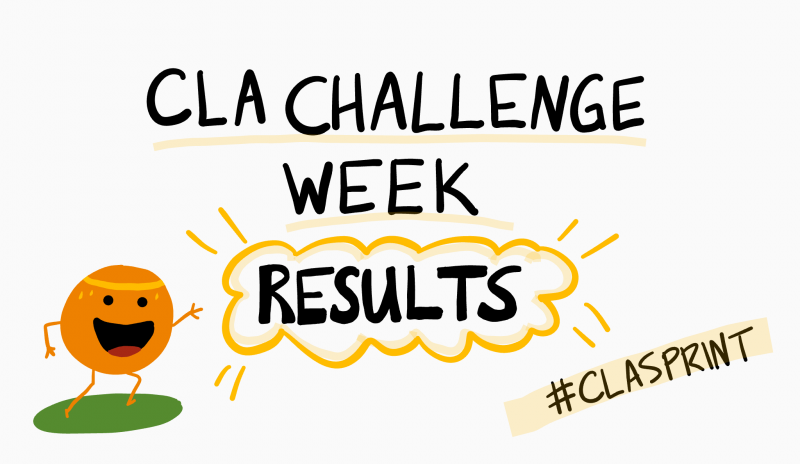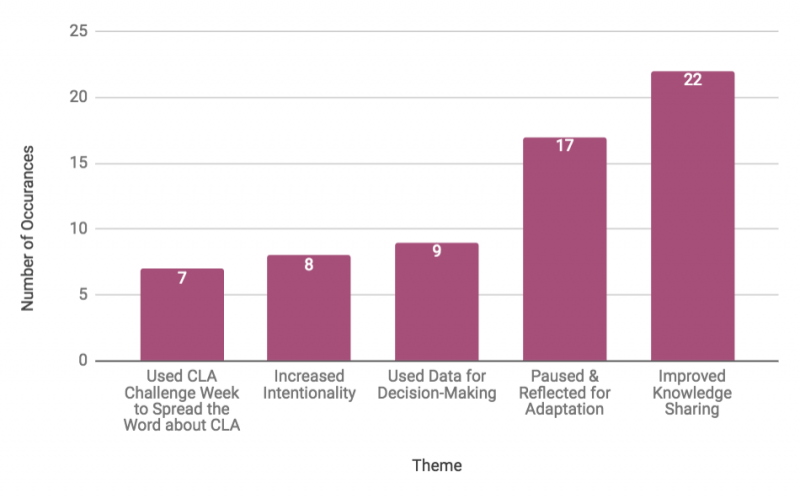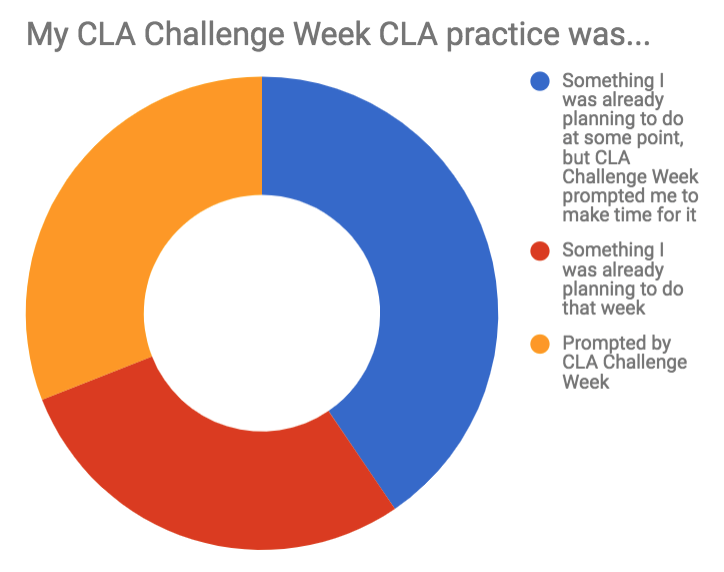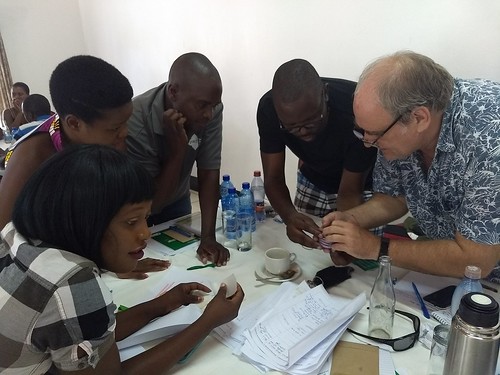The Results of CLA Challenge Week

Amy Leo is a Communications Specialist and Kat Haugh is a Monitoring Evaluation, Research and Learning Specialist on the USAID LEARN contract.
Our goal for Collaborating, Learning and Adapting (CLA) Challenge Week was to inspire USAID staff and partners to start the new year with a new CLA practice. Given that 70 individuals and teams of USAID staff and partners joined the CLA Sprint, we consider it a success in terms of participation.
But we were also interested in the results of the CLA practices tried during the week. We had prompted participants to choose CLA practices that would help them get one step closer to achieving their organizational or development goals. So, did they? How did CLA help?

After CLA Challenge Week, we sent a survey to all participants to collect information about their experience. One of the questions asked, “How did your CLA practice help you get closer to achieving your organizational or development goals?” We analyzed 42 responses (a 60% response rate) and noticed five overarching themes. We then coded each response to one or two of those themes.
So, what did participants say about how using a CLA approach helped them get closer to achieving their organizational or development goals? Below, we explore examples of these five themes and how these CLA practices are supported by evidence about the contribution CLA makes to achieving better outcomes.
Theme 1: Improved Knowledge Sharing
The most common theme, with 22 occurrences, was improved knowledge sharing. CLA Challenge Week prompted USAID staff and partners to think about how they could be more strategic in sharing technical information and learning with the right people, and bringing the right stakeholders to the table for reflection and decision-making.
For example:
- RTI International's International Development Group convened their Monitoring, Evaluation, Research, Learning and Adapting (MERLA) Community of Practice to share how members are implementing CLA in their projects and divisions. Click here to watch their CLA Challenge Week video.
- USAID’s Avansa Agrikultura Project experimented with using a new tool, WhatsApp, to allow staff working in the field to message all staff for assistance or recommendations. This form of communication has allowed solutions to be suggested in real time to farmers, reducing various types of risks. The tool has increased their effectiveness in encouraging more sustainable agriculture practices.
These examples remind us of a finding from our analysis of CLA Case Competition submissions: knowledge management generates standard good practices for broader application. In addition, we know from our research that quality knowledge management systems have a significant impact on project performance. Learn more about this evidence.
Theme 2: Paused & Reflected for Adaptation
Seventeen CLA Challenge Week commitments involved individual or group reflection on programmatic data, work plans, and processes to feed into adaptation.
For Example:
- RTI International’s StopPalu+ team implemented mini Pause & Reflect sessions into their work planning processes, discussing what they learned that day and how they could adjust their activities for the next day. This helped them to identify successful strategies for working with their partners to develop activities and adaptations. It also introduced the concept of CLA to the wider StopPalu+ team.
- Tetra Tech’s Technology for Development (T4D) Department reviewed their work plan to identify the challenges they have faced so far and successes they would like to replicate moving forward. They updated their work plan accordingly and re-prioritized their activities based on lessons learned and changing needs.
- Melissa Bevins, of the USAID LEARN contract, intentionally paused and reflected about her day on her commute home each evening. She discovered that she needs to be more intentional about guarding time between meetings to allow time for following up on the action items that come out of meetings, as well as to recharge her introverted self.
This echoes the evidence we’ve found that taking the time to pause and reflect on our work is critical to learning and improved performance. Learn more about this evidence.
Theme 3: Used Data for Decision-Making
Nine individuals and teams committed to improve their use of data for evidence-based decision-making during CLA Challenge Week.
For Example:
- American Bar Association Rule of Law Initiative is committed to improving their use of program data for decision making and focused on data visualization during CLA Challenge Week. They scheduled a meeting to kick off a series of hands-on practices paired with data visualization capacity building.
- Phong Nguyen from CRS Vietnam committed to “increase the use of data/evidence for programmatic decision making in project teams to enhance program quality". She reports that “this practice increased the ownership of learning as we collaborated to produce learning and evidence and [make] evidence-based decisions.”
We know from a June 2016 World Bank study that Monitoring & Evaluation are positively and significantly associated with achieving development outcomes when incorporated into program management and designed to support learning and decision making. Learn more about this evidence.
Theme 4: Increased Intentionality
Good CLA is intentional, systematic, and resourced. We found that CLA Challenge Week prompted participants to be more intentional about their CLA approach or be more intentional in their work.

For Example:
- USAID/Liberia and Liberia Strategic Analysis (implemented by Social Impact) reported that using CLA made them focus more intentionally on their government transition activity. During a weekly strategic planning meeting, the team revisited the strategic action plan that led the initial phases of their planning processes.
- Charlotta Sandin, of USAID/Uganda’s Monitoring, Evaluation and Learning Contract, says that her CLA practice “reminded me of, and helped me keep the bigger picture in mind when organizing and managing the details. By updating and re-reading the concept of Mental Models (Fifth Discipline, Peter Senge) and trying to apply the knowledge into daily work, we could plan for the field based portfolio reviews to be even more valuable to the mind shift that needs to be kept up to operationalize USAID/Uganda's new strategy.”
And, about two-thirds of CLA Challenge Week participants reported that their CLA practice was prompted by the CLA Sprint. As with anything, sometimes the best intentions just need a nudge to become action.
Theme 5: Used CLA Challenge Week to Spread the Word about CLA
For some participants, CLA Challenge Week was an opportunity to start or continue a discussion about CLA with their teams or organizations. Some held workshops on CLA, revisited CLA action plans, and strategized about how they might integrate CLA into programming.
For example:
- Guy Sharrock of Catholic Relief Services reports that “the opportunity presented by the CLA Sprint gave me the springboard and space to think in a new way about how to communicate CLA to a broad internal group of colleagues for whom at the moment CLA is just three letters.”
- David Ratliff, Program Officer with USAID/Azerbaijan, rallied the mission to develop 24 different CLA experiments, including the creation of an Innovations and Problem Solving Team. Click here to read David’s transparent and entertaining reflection on USAID/Azerbaijan’s CLA Challenge Week experience.
While we believe and have evidence that CLA is worth the investment, we do know that it can be challenging to convince others of this. It can be helpful to start with the message that “you are already doing CLA” and drawing on our Evidence Base for CLA (EB4CLA) resources to make the case. From our research about what it takes to create a learning organization, we know leadership support is essential, so this may be a good place to start.
CLA Begets More CLA
We noticed another overarching theme in response to the question “What might you try next week (or sometime in the future) to build on what you've started?”: CLA begets more CLA, and sometimes leads to scale-up. This theme also appeared in our analysis of the 2015 CLA Case Competition submissions (see Finding 5).
Here are some examples of how CLA Challenge Week participants plan to continue and scale-up their CLA practices:
Name & Organization | CLA Commitment | Future Plans |
Katie Grant, InterAction | Developed of a survey for CoP members to identify priority learning areas for 2018 discussion, helping us build the evidence base for Results-Based Protection and identify areas of further inquiry. | In the coming week, our team will analyze the results of the CoP members' survey to be presented at the upcoming CoP meeting, where we will also discuss our CLA reflections, and solicit CLA approaches participants are using in their own teams/ organizations. |
Ann Hendrix-Jenkins, Pact | It prompted me to process notes from an external community of practice meeting in a new way, and one that would work with the parameters of privacy and fostering a safe space for people to be frank. | Depending on feedback from the other participants, maybe we will keep the idea map as a founding and organizing document, that we keep modifying. The iterations will be a way of tracking changes and progress. |
Jessica Mirabella, USAID/BRIDGE Project | Last week, the project team convened a learning meeting with our USAID counterparts to review current MEL practices, introduce a pair of new learning capture processes, and spend time discussing a learning question focused on one of the project’s strategic approaches. | In upcoming weeks, we’ll be actively testing the new learning capture tools that we discussed in the meeting. |
Fun at Work?
Launching CLA Challenge Week was its own CLA experiment for the USAID Learning Lab team. We’ve never done anything like this and had no idea if people would sign up or take it seriously. So, we were pleasantly surprised by the level of participation and positive feedback about the experience.
We heard:
- “Thank you for putting out this challenge! It was fun!”- Cory Ragsdale, Training Resources Group
- “Thanks for this well-conceived prompt. It changed my behavior--inspired me to be more creative and thoughtful…” - Ann Hendrix-Jenkins, Pact
- “We really enjoyed participating in CLA Challenge Week and would love to see similar events.” - Molly Chen, RTI International
We share these comments not to brag about our success, but to point out that participants found enjoyment and satisfaction in trying a new approach to their work. We know from our analysis of USAID’s FEVS data that for employees at USAID missions, CLA is strongly, positively, and significantly related to employee engagement, empowerment, satisfaction, and perceived organizational effectiveness. It’s also true that continuous learning is linked with job satisfaction, empowerment, employee engagement and, ultimately, improved performance and outcomes.
As unanticipated outcomes go, “fun” is a pretty good one! We plan to build on and iterate this experiment in the future, so sign up for our mailing list to find out about future sprints.
Click on the photo below to view an album of photos submitted by CLA Challenge Week participants.




